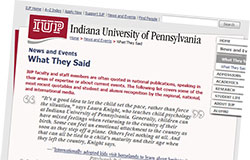I truly do enjoy my job, and I am very appreciative of the folks who go out of their way to tell me that they are happy with the media coverage I’ve arranged. One of my favorite things is when folks e-mail me or stop me out walking around campus with story ideas. Alumni, especially, are very loyal to IUP, and they like to see their university represented fairly for the accomplishments of its students, faculty, and graduates. So, I try not to take it personally when I hear, “Let’s get some good news out there about IUP for a change.” I know they care deeply about IUP and its reputation and are just trying to help.
For the past several years, I’ve been maintaining a log of media hits on the What They Said web page. I think it’s a nice record of IUP in the news, and I hope that people (hint, hint: This means YOU, blog reader) visit it often.
But I’ve not really done an “official” count of media hits for several years, so, last year, I was asked to count and measure the number of “good news” stories about IUP out there with circulation information. Here’s what we found:
There were 435 positive stories about IUP from January 2010 to January 2011 in 46 different media outlets locally, regionally, nationally, and internationally.
This does NOT include the hundreds of stories featured on our local radio station OR any stories on athletics. … I imagine the number would probably triple if I counted sports reports and features.
Anyway, these media hits ranged from places like Religion Dispatch (with a circulation of 2.3 million), the New York Times (circulation 740,007), and the Minneapolis-St. Paul Star Tribune (circulation 534,750) to 29 hits in the Pittsburgh Tribune-Review (circulation 393,071), 22 hits in the Pittsburgh Post-Gazette (circulation 319,987), and 310 stories in the Indiana Gazette (circulation 16,000). Using what researchers call the “industry multiplier” (how many people actually read or hear news reports), this means that good news at IUP “for a change” reached 76,474,622 people. Yes, 76.5 million people.
Of course, we don’t catch every media hit, so this is just what I’ve been able to document. I think it’s a pretty impressive number.
That’s the good news. But be assured, I’m working to get that 76.5 million up past 100 million for 2011-2012,…so story tips and ideas are always welcome!

